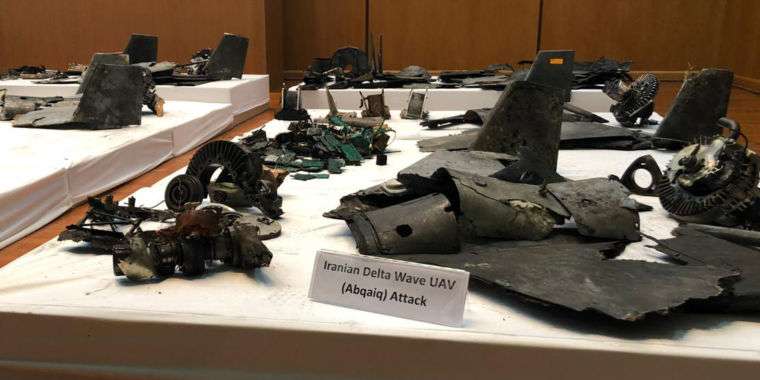
More evidence points to Iranian cruise missiles, drones in attack on Saudi oilfield

-
Drone wreck and cruise missile wreckage from the attack on the Aramco Abqaiq oil refinery is displayed during a Saudi Arabian Ministry of Defense news conference in Riyadh on Wednesday, Sept. 18, 2019.Vivian Nereim/Bloomberg via Getty Images
-
The Quds-1 cruise missile, on display during a Houthi weapons unveiling on July 7, 2019.
Debris gathered from the drones and missiles used to attack an oil field and refinery in eastern Saudi Arabia increasingly lends credence to US and Saudi accusations that Iran was in some way behind the attacks. Other evidence presented thus far also suggests that the attacks may have been launched from Iran rather than Yemen, as the leadership of the Houthi militia fighting Saudi Arabia there has claimed.
A total of 25 drones and missiles were used in the attack. The missiles appear to have been identical to the Quds-1 cruise missile revealed by Ansar Allah (the Houthi militia) in a weapons display on July 7. The drones were delta-winged, propeller-driven unmanned aircrafts with stabilizer fins at the tips of each wing.
Quds it be?
The Quds-1 is a smaller missile than the Soumar—Iran’s clone of a Soviet-era cruise missile obtained from Ukraine in 2001—and its latest iteration, the Hoveyzeh. The Quds-1 uses what appears to be a Czech-built turbojet engine, the PBS Aerospace TJ100 (which PBS advertises as “especially suitable for unmanned aerial vehicles”) stuck onto its upper fuselage for propulsion.
Based on analysis of photographs and other evidence, Fabian Hinz of the James Martin Center for Nonproliferation Studies and others have posited that the Quds-1 was used in the September 14 attacks. A TJ100 engine was found in the wreckage, and the missile had a smaller diameter than the Soumar, with rounded control fins identical to those in photos of the Quds.
This doesn’t get Iran off the hook for the attack. Drones displayed by Iran have had TJ100 turbojets (or engines that are nearly identical knockoffs). And the Houthi Ansar Allah, while having some technical capabilities, would be hard-pressed to produce turbojet engines—let alone an entire cruise missile with terrain following systems and satellite navigation.
There’s a possibility of an even more direct Iranian connection: while the Soumar would have plenty of range to be launched from Yemen and strike northeastern Saudi Arabia, the TJ100 has significantly less thrust and is less fuel efficient than the engine used in the bigger missile. In order to reach its target, it would more likely have had to been launched from southwestern Iran. While Iran has not publicly displayed the Quds-1 under any name, it is likely that it is a simplified weapon built specifically for Iran’s proxies, just as Iran has done with some drone weapons.
The tempest
-
An attendee photographs a display of drone wreckage said to be from recent attacks during the Ministry of Defense news conference in Riyadh, providing a human for scale.Vivian Nereim/Bloomberg via Getty Images
-
Drone wreckage including one described as an Iranian Delta Wave UAV. The design resembles earlier delta-winged “kamikaze” drones built by Iran.Vivian Nereim/Bloomberg via Getty Images
-
A damaged drone said to be from an attack dated May 14, 2019 is provided for comparison during the Ministry of Defense press conference.ivian Nereim/Bloomberg via Getty Images
The drone wreckage from the attack introduces another set of questions. The “suicide” uncrewed aerial vehicles, or “loitering munitions” as they are referred to in the UAV industry, were similar in design—but not identical—to a drone Iran has referred to in the past as the Toofan (“Tempest”).
Saudi Ministry of Defense officials identified the drones as “Iranian Delta Wave UAVs.” It’s doubtful that these were actually Toofan drones. Instead, it’s more likely that they were an updated design based on the same delta-wing, “low observable” shape. According to a 2013 report in Iran’s Mehr News, the Toofan’s top speed is 250 kilometers per hour (155 miles per hour), and it can fly for “over an hour.”
That would not give the drone the endurance to reach the targets in Saudi Arabia. Furthermore, the Toofan is optically guided—”a front-facing camera in the nosecone transmits live images until the moment of impact, to increase homing accuracy.” That does not appear to be the case with the drones used in the September 14 attacks. However, the drones were small (roughly 2 meters or 7 feet long) and probably only had a range of about 400 kilometers.
Again, given that it is about 1,250 kilometers from Yemen to the target zone of the attacks, it’s highly unlikely that these drones were launched by Houthi forces there. It’s more likely that, as in similar attacks earlier this year, the drones were launched by Iran-backed militia from Southern Iraq.
Iraq’s government has denied that the attacks were launched from Iraqi territory, but a drone was spotted flying through Kuwaiti airspace on the night of the attack.
Listing image by Bloomberg, via Getty Images




